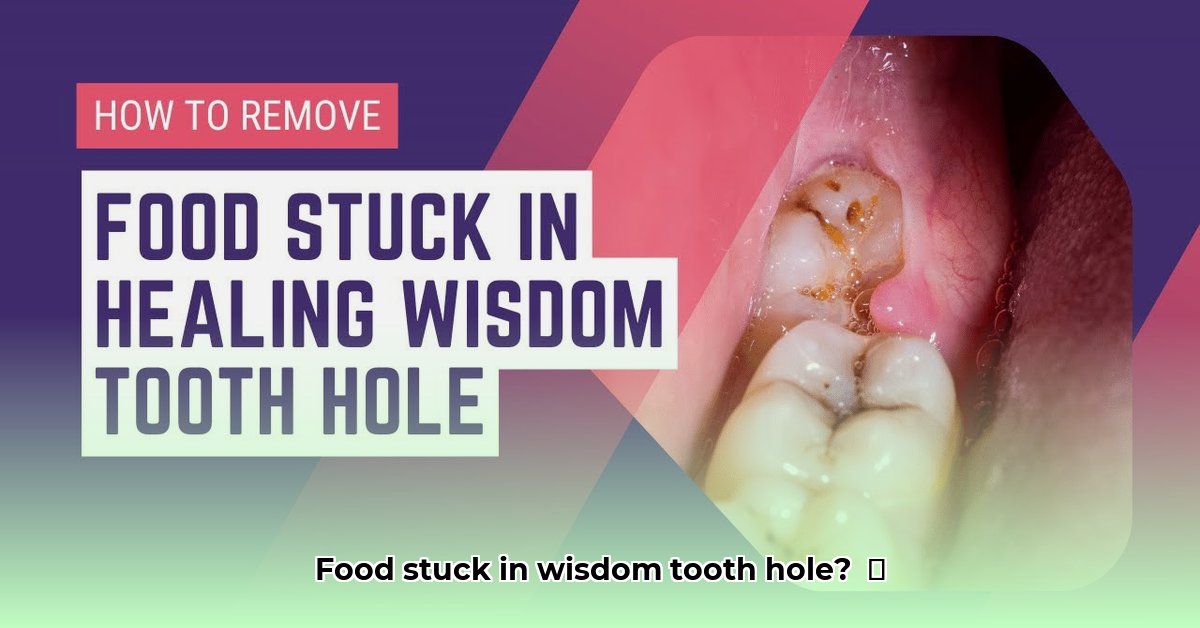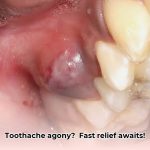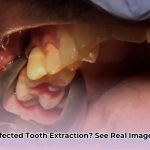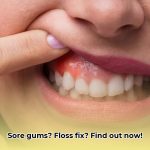Recovering from wisdom tooth extraction? It’s common for food to get stuck in the empty socket, which can be a real pain. This guide provides actionable steps to prevent food impaction, gently remove it if it occurs, and know when to seek professional dental care for a smoother recovery. For more information on infected teeth, see [this helpful guide](https://mearnes.com/extract-a-tooth-that-is-infected/).
Addressing The Problem of Food Stuck in Wisdom Tooth Hole
Food getting trapped in the hole after wisdom tooth removal is a common and often irritating problem. Understanding how to prevent and manage this situation is crucial to avoid complications such as infection or dry socket. Dry socket can cause intense throbbing pain.
Proactive Prevention Strategies: A Shield Against Food Impaction
Think of the empty wisdom tooth socket as a wound that requires time to heal. Gentle care and smart food choices help prevent food from lodging there.
- Soft Food Diet: For the initial days post-extraction, consume soft, easy-to-chew foods like creamy soups, yogurt, applesauce, and mashed sweet potatoes.
- Mindful Chewing: Chew on the opposite side of your mouth to minimize stress on the healing site.
- Irritant Avoidance: Refrain from using straws and avoid smoking and alcohol to promote healing and prevent dry socket.
Identifying Food Impaction and The Need for Specialized Cleaning
Identifying food impaction through subtle signs is the first step toward solving this problem.
If food gets stuck, be alert for the signs below. It could be a persistent dull ache or sudden sharp pain. You might even see food particles within the socket. These are indicators that something isn’t right and needs your attention!
Gentle Removal Techniques: First-Line Defense Strategies
Here’s a step-by-step approach to safely remove trapped food particles:
- Warm Saltwater Rinse: Mix ¼ to ½ teaspoon of salt into 8 ounces of warm water. Gently swish around your mouth, avoiding direct force into the extraction site; repeat this several times daily, especially after meals. Saltwater’s natural antimicrobial properties can help to reduce your risk of infection.
- Irrigation Syringe: If rinsing isn’t enough, use an irrigation syringe with lukewarm water, aiming carefully to prevent harm to healing tissues. Gently direct the stream to dislodge any particles.
- Water Flosser: Only use with caution, and with dentist approval, avoiding excessive pressure that could damage the area. Use the lowest pressure setting and direct the stream away from the socket.
When to Seek Professional Dental Help Immediately
Certain situations require prompt attention from a dental professional to prevent serious complications.
If you encounter any of these warning signs, contact your dentist immediately:
- Severe Pain: Throbbing pain not relieved by over-the-counter medication.
- Persistent Bleeding: Bleeding that continues despite applying pressure.
- Signs of Infection: Swelling, redness, or pus around the extraction site.
- Fever: Elevated body temperature, which could indicate an infection.
- Difficulty Swallowing or Breathing: These could be signs of a serious infection or complication.
Healing Timeline: Realistic Expectations for Recovery
Typically, discomfort from food impaction should lessen within one to two weeks; however, consult with your dentist if problems persist beyond three weeks. Full healing of the socket can take 4-6 weeks.
Maintaining Good Oral Hygiene after Wisdom Tooth Removal: A Long-Term Strategy for Healing
Keeping the area clean is very important to ensure proper healing. Gently brush and floss around the extraction area, avoiding direct contact with the healing site for the first few days. Use a soft-bristled toothbrush and be extra gentle.
By implementing these preventive and management techniques, you can significantly decrease the chances of food impaction and promote a smoother recovery after wisdom tooth extraction. Consult your dentist for personalized advice. According to the American Dental Association, maintaining good oral hygiene is essential for preventing complications after wisdom tooth extraction.
Key Strategies for Managing Food Particles in Wisdom Tooth Extraction Site
Key Takeaways:
- Gentle techniques are crucial for food removal without disrupting healing.
- Warm saltwater rinses serve as a first line of defense against inflammation and infection.
- Irrigation syringes offer more targeted cleaning for stubborn particles.
- Water flossers can be helpful, but use with extreme caution to prevent damage.
- Severe pain or signs of infection warrant immediate dental intervention.
Preventing Food from Getting Stuck: Early Dietary Modifications
Preventing food from becoming trapped is more manageable than addressing the issue. Remember that wisdom tooth extraction leaves a vulnerable spot.
- Diet is crucial: Adhere to soft foods for the initial days. Think mashed potatoes, yogurt, applesauce, well-cooked pasta, pudding, and broth-based soups.
- Chew mindfully: Protect the extraction site during the initial recovery by chewing on the opposite side of your mouth.
- Avoid irritants: No straws, smoking, or alcohol, as these actions can lead to dry socket and delay healing.
Recognizing the Signs of Impaction: Monitoring Your Symptoms
You might experience discomfort or pain near the extraction site. Sometimes, you can even see the offending particles. Don’t ignore these signals in order to prevent prolonged issues.
Gentle Removal Methods: Step-by-Step Guide after Wisdom Tooth Extraction
- Warm Saltwater Rinse: Mix 1/4 to 1/2 teaspoon of salt in 8 ounces of warm water; gently swish the solution around your mouth, avoiding force into the extraction socket. Repeat several times a day and after meals.
- Irrigation Syringe: If a saltwater rinse isn’t enough, use an irrigation syringe. Gently flush the area with a stream of lukewarm water to dislodge food particles. Aim carefully to avoid irritating the healing tissue.
- Water Flosser: Water flossers aren’t usually recommended immediately after surgery, but if your dentist approves, use it gently and in surrounding areas only, using the lowest pressure setting.
The goal is to dislodge the food gently, not harm the healing tissue.
When to Call Your Dentist and Seek Professional Cleaning
While home remedies offer effective first aid, some situations need professional help to prevent serious problems.
Contact your dentist immediately if you experience:
- Severe pain
- Excessive bleeding
- Swelling
- Signs of infection (pus, bad odor)
- Fever
- Difficulty Opening Your Mouth
- Numbness
Expected Healing Timeline: Wisdom Tooth Extraction Recovery
Most food impaction resolves within a week or two; if you’re still struggling beyond that point, contact your dentist. Complete healing of the socket can take 4-6 weeks.
Advanced Techniques For Preventing Dry Socket After Wisdom Tooth Removal
Key Takeaways:
- Avoid using straws immediately after surgery to prevent dislodging the blood clot.
- Eat soft foods for the initial days to protect the sensitive extraction site from trauma.
- Rinse gently with warm salt water regularly to maintain cleanliness and promote healing.
- Abstain from smoking to dramatically reduce the risk of developing a dry socket.
- Contact your dentist promptly if you experience severe pain or any signs of infection.
Understanding Food Impaction and Dry Socket: Preventative Measures
Understand how to prevent food from becoming trapped in the extraction socket. Food particles lodged in the healing wound can cause infection and pain, leading to alveolar osteitis; preventing food impaction is a crucial part of Preventing Dry Socket After Wisdom Tooth Removal: Advanced Techniques and Strategies.
Preventing Food From Getting Stuck: An Essential Post-Op Plan
Food impaction prevention should be an essential part of your post-operative plan.
Immediate post-operative care is vital; here’s how to minimize food impaction:
- Diet Modification: Stick to a liquid or soft food diet for the first few days to avoid direct contact with the healing site. Smoothies, broth-based soups, and yogurt are excellent choices.
- Chewing Strategy: When chewing solid foods, focus on the opposite side of your mouth to avoid disturbing the extraction site.
- Harmful Habits: Avoid straws, smoking, and alcohol, as these activities create suction and can disrupt the blood clot. Additionally, smoking impairs healing.
Recognizing Food Impaction: Identifying Warning Signs
Food impaction isn’t always obvious; be observant and watch to prevent problems.
Watch for these warning signs:
- Increased pain at the extraction site.
- A noticeable bad taste or odor at the back of your mouth near the extraction site.
- Visible food particles in or around the socket.
- Swelling or redness around the extraction site.
Gently Removing Trapped Food After Extractions
If you suspect food impaction, act promptly but gently.
Step 1: The Warm Saltwater Rinse
Use the saltwater rinse as a first action. Mix 1/4 to 1/2 teaspoon of salt in 8 ounces of warm water; swish gently to avoid harming the extraction site. Repeat several times a day, especially after meals, for the first week.
Step 2: Irrigation Syringe
Use an irrigation syringe carefully if the saltwater rinse isn’t enough. Your dentist or oral surgeon can guide you on the appropriate use to avoid damaging the healing area. Never force anything into the socket.
Step 3: Water Flosser (Use With Caution):
Water flossers can be helpful, but should be used with extreme caution and only with the approval of your dentist. Direct the stream away from
- Achieve Anesthesiology Work-Life Balance: Your Guide - December 4, 2025
- Unlock Young Doctors’ Work-Life Balance: Actionable Strategies Now - December 2, 2025
- Unlock Life Harmony: Work-Life Integration Guide - November 30, 2025
















